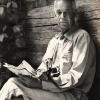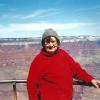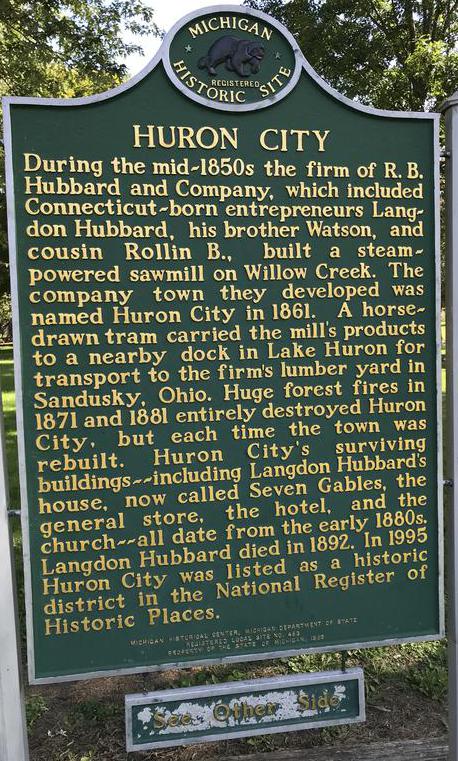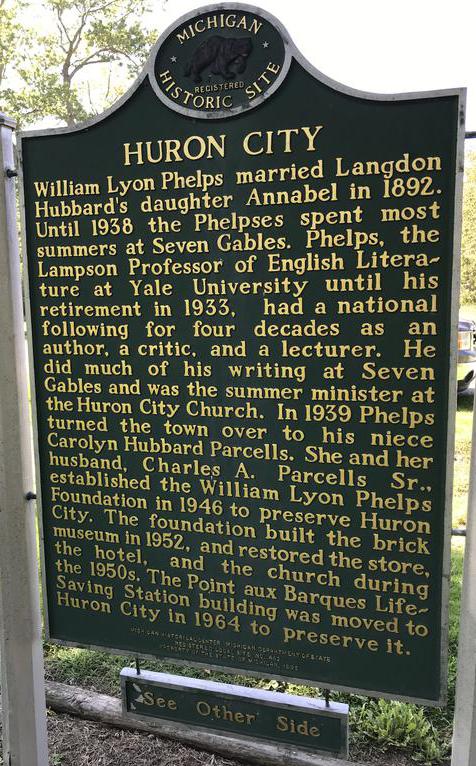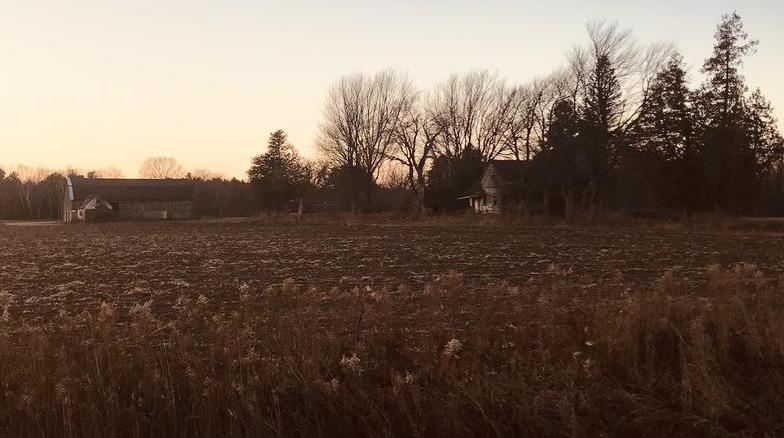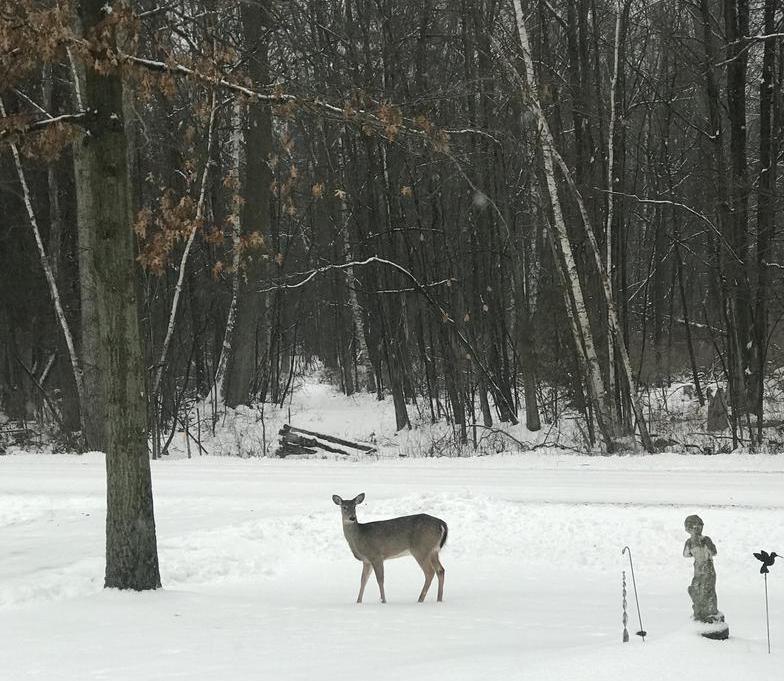Welcome to SCHOCK MCCOY PRODUCTIONS by J.H. McCoy. This website is named in honor of my mother,
Gloria (Schock) McCoy, and dedicated to her memory. Since it was founded in 2015, her JOURNAL and ALBUM have always been prominent features, but now some of her recipes have been added to the website (RECIPES).
The format of the HOMEPAGE changes during the year. It often contains articles from my hometown newspaper.
The NEWS section features recent photographs and comments on the local scene as well as more of my articles.
PHOTO-ESSAYS is a record of my trips to iconic locations in the U.S. A short history of the Schock family, written over 50 years ago (1970) by my great-uncle, Edward D. Schock, is presented in HISTORY. I edited it in 2020.
I hope that you will always find something interesting on this website and that you will tell others about it.
Thank you for stopping by. Please sign the Guest Book, and come back soon!
J.H. (John Herbert) McCoy
9636 Roberts Rd., Harbor Beach, MI 48441 // [email protected] // (989) 551-9487 (cell)
ESTABLISHED:
JANUARY 30, 2015
SCHOCK MCCOY
PRODUCTIONS

***CLICK ON THE NAME FOR A SHORT VIDEO***
(Nobel Speech)
"TEMPUS FUGIT"
(Click on small "pics" to enlarge)
Canada geese fly by.
TODAY
YESTERDAY
SAND BEACH TOWNSHIP
&
MICHIGAN'S THUMB
J.H. MCCOY
++10th Anniversary 1/30/25++
NEW
NEW
NEW
"THE SCHOCK FAMILY TREE" by Edward D. Schock (1970) edited by J.H.McCoy
Read it in HISTORY
REST IN
PEACE
JOHN MUIR (NATIONAL PARK SERVICE VIDEO) "A GLORIOUS JOURNEY" - 22 MINUTES
Born 102 years ago, Jan 30, 1923
FROM THE MINDEN CITY HERALD BY J.H. MCCOY
TIMBERDOODLE ON THE LAWN - 6/9/23
SNOWY OWL AT THE HARBOR BEACH MARINA
APRIL 3-4, 2023
ARTICLE IN "THE MINDEN CITY HERALD" - 4/13/23
THE SNOWY OWL'S "SPRING FLING" ENDED ON APRIL 5!
NOBODY HAS SEEN IT SINCE.
SNOWY OWL IN HARBOR BEACH
THE MINDEN CITY HERALD
APRIL 13, 2023
A Snowy Owl was seen and photographed at the Harbor Beach Marina on Monday and Tuesday of the first week of April. It was sitting among the boulders in front of the rental cabins at the north end of the harbor. The heavily streaked “Snowy” was extremely tame and ignored cars and traffic. It even tolerated pedestrians, walking by on the sidewalk.
I took pictures on both days from a parked vehicle. I left the car only once. On Tuesday morning, I pulled up to the line of boulders without seeing the owl. I was going to check the rocks for signs of a kill. The photographer who took pictures on the first day said that the owl was feeding on something.
I got out of the car, walked around the back of it, and then suddenly froze when I saw the yellow eyes. The Snowy Owl was sitting quietly among the boulders about 50 feet away, watching my every move. I retraced my steps, climbed back into the car, and once again snapped some pictures. (The owl photo was one I took that morning.)
Later, I began to wonder if the owl was sick or injured. After all, I had never seen it fly, and it was in the same general location for two days in a row. But it looked healthy and moved normally.
Then on Wednesday, it was gone - nobody has seen it since. Evidently, the springtime Snowy Owl decided that it was finally time to end it strange sojourn
in Harbor Beach and return to its home on the Arctic tundra.
*********
More pictures of the Snowy Owl can be found on the Homepage of my website, Schock McCoy Productions. www.schockmccoyproductions.com
After the owl disappeared, I posted several iPhone pictures of it on “Birding Michigan,” a Facebook site for people interested in Michigan birds. I also
reported it to eBird, the electronic birding website of the Cornell Lab of Ornithology. www.ebird.org
Out of sync with the calendar, a Snowy Owl seems at home in the boulders at the Harbor Beach Marina.
"HOUSE OF SEVEN GABLES" - HURON CITY
ICONIC HARBOR BEACH LIGHTHOUSE (1885) AND MIGRATING CANADA GEESE
BLACK-BELLIED PLOVERS 6/13/24
"THE EARTH LAUGHS IN FLOWERS."
RALPH WALDO EMERSON
OPOSSUMS ON THE MOVE
in THE MINDEN CITY HERALD - JULY 13, 2023
READ THE ARTICLE IN "THE CAMERA SKETCH BOOK"
"O PIONEERS!" by WILLA CATHER (1913)
"The land belongs to the future... that's the way it seems to me. How many of the names on the county clerk's plat will be there in fifty years? ... We come and go, but the land is always here. And the people who love it and understand it are the people who own it --- for a little while." Alexandra Bergson - final chapter
(photo: deserted homestead in Huron County)
FRESH SNOW AND A TEMPORARY "LAWN ORNAMENT,"
ROBERTS RD., SAND BEACH TWP.
posted on Facebook, January 23, 2024
CHANGING FACE OF AGRICULTURE:
BALED WHEAT STRAW IN THE THUMB
LABOR-INTENSIVE SQUARE BALES ARE GONE!
PRESCRIBED BURN 5/2/24
WILD BERGAMOT
LIKED BY BUTTERFLIES AND BUMBLEBEES
GROWING WILD WHERE THE BACKLAWN IS UNCUT
(Photo on "John H. McCoy" Facebook page, August 9, 2023. "Schock McCoy Productions" is also on Facebook with literary and historical content. "Like Us" there.)
FARM COUNTRY RAINBOW
ANDY DUFRESNE - "THE SHAWSHANK REDEMPTION"
"HOPE IS A GOOD THING, MAYBE THE BEST OF THINGS, AND NO GOOD THING EVER DIES."
BEST "BACKYARD BUTTERFLY" ... SO FAR
EASTERN TIGER SWALLOWTAIL ON WILD BERGAMOT
AUGUST 20, 2023
SANDHILL CRANES
IN HARBOR BEACH 5/23/24
"ONCE IN A BLUE MOON"
LAKE HURON - SAND BEACH TOWNSHIP AUGUST 30, 2023
The next BLUE MOON will occur on May 31, 2026. However, a
BLUE MOON, which is also a "SUPERMOON," will not happen until 2037.
MIGRATING WINTER WREN IN THE BACKYARD
October 15, 2023 - through a window
WINTER WREN - "a very round, dark wren, told from the House Wren by its smaller size, much stubbier tail, stronger eyebrow, and heavily barred belly. Often bobs body and flicks wings. Mouselike and secretive; stays near the ground." [from the "Peterson Field Guide To Birds"]
DITTO - MORE MIGRANTS - HERMIT THRUSH
POSTED ON FACEBOOK: "A small flock of Canada Geese at Harbor Beach, flying off to feed as a December day comes to an end (12/6/23)."
Good response: 43 LIKES; 7 COMMENTS.
ANCIENT ENEMIES IN HURON COUNTY
NOVEMBER 14, 2023
POSTED ON FACEBOOK: DECEMBER 3, 2023
LIKE THE "BIG WOODS" - STANDING CORN IS A PLACE OF SAFETY FOR DEER DURING THE FIREARM DEER SEASON,
WHICH BEGAN ON NOVEMBER 15, 2023.
STANDING CORN IN MID-NOVEMBER (HURON CO.)
GLORIA (SCHOCK) MCCOY
CLICK
ON PIC
+++ NEW MATERIAL
ON MY WEBSITE HAS
BEEN LIMITED DUE TO
HEALTH ISSUES,
SEPT. 1, 2024.
During spring migration in May, a flock of Black-bellied Plovers spent a few days on the shoreline at Wagener County Park south of Harbor Beach. Perhaps they were waiting for more favorable winds or just resting during their long migratory journey to the Arctic tundra. (Black-bellied Plovers are the largest members of the plover family and nest the farthest north.)
The adult male in breeding plumage has a white crown and nape and a black face and belly; the female is slightly duller and averages less black overall.
The number of migrating plovers at the park fluctuated: one day there were about 50 on
a small spit at the water’s edge; the next day, close to 100. (Later, a birder with a scope counted 140 Black-bellied Plovers just north of the park – no doubt, some of the same birds.) The flock also contained a few other shorebirds like Dunlins and Ruddy Turnstones.
In breeding plumage, Black-bellied Plovers are easy to recognize; but after the summer molt, their distinctive black pattern is replaced by a white belly and a mottled, brownish gray color.
During fall and winter, birders must rely on other field marks to identify them - like their stocky plover shape, hunched posture, and short, thick bill. In flight, they show
a white wing-stripe, a whitish rump and tail, and black under the wings at their “wingpits.”
Black-bellied Plovers might visit Wagener County Park again during fall migration, but they will be harder to identify in their dull nonbreeding plumage.
In early May, a breeding pair of adult Sandhill Cranes was seen in a grassy field near
the Grice House Museum in Harbor Beach. They continually probed the grass with their long, dagger-like bills and seemed preoccupied by their search for food. Occasionally, they engaged in some brief courtship displays, spreading their wings and “dancing.”
The cranes did not react to my vehicle, and I took the pictures from the car window.
It was the first time I ever photographed Sandhill Cranes inside the city limits.
In early spring, I have often heard and seen high-flying Sandhill Cranes in the sky over my house in Sand Beach Township. Usually, I hear their loud, trumpet-like calls long before I locate them in the sky overhead.
Sandhill Cranes are more numerous farther west. In fact, their name refers to the Sand Hills of central Nebraska, where over half-a-million cranes rest and refuel in the spring
at various stopover points along the Platte River.
Most Sandhill Cranes use the Central Flyway during spring migration. But, as they expand their range eastward on the Mississippi Flyway, they are seen more often in the Thumb.
************************
During my twelve years with THE MINDEN CITY HERALD, I have written other articles about Sandhill Cranes. They are listed below and can be found in the Archives of the newspaper (www.mindencityherald.com).
1. Sandhill Cranes…. Early Migrants - July 31, 2014
Sandhill Cranes…. Early Migrants - July 31, 2014
2. Sandhill Cranes - November 19, 2015
Sandhill Cranes - November 19, 2015
3. Hunting Sandhill Cranes? – June 20, 2019
Hunting Sandhill Cranes? – June 20, 2019
4. Sandhill Cranes in Minden Township (photo) - May 28, 2020
Sandhill Cranes in Minden Township (photo) - May 28, 2020
The Department of Natural Resources (DNR) conducted a “prescribed burn” in the Verona State Game Area on Friday, April 26. With the Verona Township Cemetery as
a backdrop, the 15-man “burn team” began lighting back fires along Philp and McAllister Roads, which slowly burned into the wind (SE).
When the back fires had charred and blackened a sufficient perimeter, the DNR ignited the grasslands in front of them. A brisk wind fanned the flames and drove them toward the newly created “fire-stop.” Clouds of smoke billowed into the sky as fast-moving fires raced through the dry grass.
Three sections of grassland (about 300 acres) were burned during the afternoon. At 10:30 P.M., some DNR personnel were still at the scene to make certain that all fires were completely extinguished.
“Prescribed burns” are used by the DNR to improve grassland habitat, but grass fires can be unpredictable and dangerous. Fire safety is always a primary concern.
***************************
Eight years ago, I wrote a full-length article on the same subject, “Fire Comes to the Verona State Game Area.” It can be found in the Archives of The Minden City Herald (5/5/2016). www.mindencityherald.com
10TH
ANNIVERSARY
JAN. 30, 2025
10
BACKYARD BUTTERFLIES
APRIL 17, 2025
EAGLE-TIME IN HURON COUNTY - 2025
PAUL REVERE AT 250
Next year, on July 4, 2026, the United States will celebrate her 250th birthday. Also called “Independence Day,” the 4th of July will be the biggest patriotic celebration the country has seen since the Bicentennial of 1976. There will be military ceremonies and parades, prayers and speeches, concerts, fireworks, and backyard barbecues. The nation will pause to remember the revolt against British rule and the birth of a free and independent country, “deriving its power from the consent of the governed.” The Declaration of Independence announced the new reality on July 4, 1776:
We, therefore, the Representatives of the united States of America, in General Congress, Assembled….solemnly publish and declare, That these United Colonies are, and of Right ought to be Free and Independent States; that they are Absolved from all Allegiance to the British Crown, and that all political connection between them and the State of Great Britain, is and ought to be totally dissolved….
However, to declare independence is one thing; to make it a reality is quite another. In 1776, a war was necessary to settle the issue, and it had already begun the previous year.
250 years ago on April 19, 1775, the first shots of the Revolutionary War were fired at Lexington and Concord in Middlesex County, Massachusetts. British troops, marching from Boston to confiscate arms and make arrests, were met by armed bands of colonials, who routed the Redcoats and drove them back toward the city.
On the previous night, April 18, 1775, Paul Revere and other couriers, like William Dawes and Dr. Samuel Prescott, rode through the dark countryside to warn the citizenry of the approaching British columns. Their actions played a crucial role in the battles of Lexington and Concord because they deprived the British soldiers of the element of surprise. The aptly named “Minutemen” (colonial militia ready to fight at a minute’s notice) had been forewarned, and they were armed and ready to face the British regulars when they arrived.
Actually, Paul Revere never completed his ride into Concord to warn the townspeople of the approaching danger. Near Lexington, he was detained and questioned by a British patrol, and then later released. But other couriers like Dawes and Prescott rode on. They were able to alert the citizens of Concord and neighboring towns that “The Regulars are coming.”
After the Revolutionary War, Revere’s part in spreading the alarm to Middlesex County was largely forgotten; after all, he was only one of several colonial riders. Revere continued his work as a silversmith and later operated a hardware store and a foundry, producing iron, copper, and brass. When he died in 1818 at the age of 83, his obituary did not mention his ride to warn Middlesex County, but focused rather on his business sense as a celebrated Massachusetts silversmith and metal worker.
In 1860, eighty-five years after the event, the American poet Henry Wadsworth Longfellow wrote a narrative poem called, “Paul Revere’s Ride.” It recalled the night of April 18, 1775, and what came to be known as the “midnight ride.” The poet eliminated all the other couriers and gave full credit to Paul Revere. Other historical inaccuracies were ignored, and “the eighteen of April, in Seventy-Five” passed into legend. The first two stanzas of Longfellow’s poem are quite familiar to all:
Listen, my children, and you shall hear
Of the midnight ride of Paul Revere,
On the eighteenth of April, in Seventy-Five:
Hardly a man is now alive
Who remembers that famous day and year.
He said to his friend, “If the British march
By land or sea from the town to-night,
Hang a lantern aloft in the belfry-arch
Of the North-Church-tower, as a signal-light,—
One if by land, and two if by sea;
And I on the opposite shore will be,
Ready to ride and spread the alarm
Through every Middlesex village and farm,
For the country-folk to be up and to arm.”
On April 18, 2025, we commemorate the 250th anniversary of that “midnight ride,” now transformed by the poetry of Henry Wadsworth Longfellow into one of the pivotal episodes of the American Revolution. According to Longfellow: The fate
of a nation was riding that night.
In the poem, Revere alerted Lexington and then rode on to Concord. Longfellow ignored his arrest by the British and left out the other riders. Using what is called “poetic license,” he made Revere the singular hero of the story:
It was one by the village clock,
When he galloped into Lexington.
He saw the gilded weathercock
Swim in the moonlight as he passed,
And the meeting-house windows, blank and bare,
Gaze at him with a spectral glare,
As if they already stood aghast
At the bloody work they would look upon.
It was two by the village clock,
When he came to the bridge in Concord town.
He heard the bleating of the flock,
And the twitter of birds among the trees,
And felt the breath of the morning breeze
Blowing over the meadows brown.
And one was safe and asleep in his bed
Who at the bridge would be first to fall,
Who that day would be lying dead,
Pierced by a British musket-ball.
Thus, Paul Revere rode into “history”:
So through the night rode Paul Revere;
And so through the night went his cry of alarm
To every Middlesex village and farm.
“Paul Revere’s Ride” was written in 1860, the year before the American Civil War began. It was a time of great political turmoil and upheaval as the debate over slavery threatened the Union. No doubt, Longfellow believed that once again the nation was in peril - the dangers of the contemporary dispute reminded him of the crisis of 1775.
According to the final stanza of Longfellow’s poem, Paul Revere may be compelled to “ride again.” Any time America is in crisis and the nation’s survival is at stake,
as it was in “Seventy-Five,” Paul Revere’s call to arms will be heard “on the night wind of the past.” His spirit will ride through the streets and spread the alarm, calling all patriotic citizens to rise up and defend their country:
For, borne on the night-wind of the Past,
Through all our history, to the last,
In the hour of darkness and peril and need,
The people will waken and listen to hear
The hurrying hoof-beats of that steed,
And the midnight message of Paul Revere.
This week, we remember what happened 250 years ago in Massachusetts: Paul Revere’s ride, April 18, 1775, and the Battles of Lexington and Concord the following day, April 19, 1775.
There would be many other famous names and places added to the history of the Revolutionary War two and a half centuries ago: Bunker Hill, the Delaware Crossing, Valley Forge, George Washington, Lafayette, John Paul Jones, Nathan Hale, and finally, Yorktown in 1781, where British General Cornwallis surrendered his 7,000-man army as his military band played, “The World Turned Upside Down.” It was a stunning defeat for one of the most powerful armies in the world.
The Revolutionary War did not officially end until the ratification of the Treaty of Paris in 1783, but it all began 250 years ago in Lexington and Concord…. and Paul Revere was part of the story.
Schock McCoy Productions - www.schockmccoyproductions.com
The equestrian statue of Paul Revere with the Old North Church in the background is a popular tourist attraction in Boston, Massachusetts, especially this year, the 250th anniversary of Revere's "midnight ride" on April 18, 1775. - file photo -
TIGER SWALLOWTAIL, GREAT SPANGLED FRITILLARY & MONARCH BUTTERFLIES
WILD
BEE
BALM
BERGAMOT


